A Dynamic Shelter Location and Victim Resettlement Model Considering Equitable Waiting Costs
Abstract
:1. Introduction
- We simultaneously consider waiting cost and fairness in the DMPLA problem.
- We consider fairness from two aspects. Firstly, we consider the unit waiting cost gap between two different disaster areas over the whole victim resettlement process. Secondly, we set an allocation percentage (or service level) threshold in each time period.
- We formulate a mixed integer linear programming model and a numerical example is investigated to explain the model. Furthermore, a case study is conducted to demonstrate the applicability of the DMPLA model to practical problems.
2. Literature Review
2.1. Shelter Location and Victim Resettlement
2.2. Human Suffering
2.3. Fairness
3. Problem Description
3.1. Shelter Location
3.2. Victim Allocation
4. Formulation
- (1)
- Indices
- (2)
- Parameters
- (3)
- Decision variables
4.1. Waiting Cost
4.2. Fairness
4.2.1. Waiting Cost Equity
4.2.2. Service Level Equity
4.3. Mathematical Model
5. Illustrative Example
5.1. Fairness Interpretation
5.2. Waiting Cost Verification
6. Case Study
6.1. Case Background and Data Estimation
6.1.1. Initial Demand of Each Disaster Site
6.1.2. Initial Distance between a Demand Point and a Candidate Shelter Location Point
6.1.3. Monetary Costs
6.1.4. Periodic Capacities for Victim Transportation and Building Shelters
6.1.5. Weight for Equity
6.1.6. Periodic Service Level
6.2. Numerical Results
7. Conclusions
- The DMPLA model reduces people’s waiting time for resettlement through minimizing victims’ waiting costs. This improves the performance of post-disaster operations significantly from a perspective of humanism, and at the same time with an acceptable increase of monetary costs.
- The proposed DMPLA model provides an equitable decision, which is important to improve people’s satisfaction. Appropriate weight value settings can bring an obvious improvement in fairness without significantly increasing waiting costs.
- The tradeoffs between waiting cost and equity can be easily controlled by adjusting the values of weight under the support of Pareto analysis.
- Transportation capacity and building capacity significantly impact the decision. In addition, they have different binding force. Thus, it is very important to assign limited resources to purchase shelters and deliver victims in a scientific way.
- An appropriate periodic service level requirement will not lead to an obvious increase of objective value and related costs while guaranteeing the periodic equity.
Author Contributions
Funding
Conflicts of Interest
References
- Below, R.; Wallemacq, P. Annual Disaster Statistical Review 2017. Centre for Research on the Epidemiology of Disasters. 2018. Available online: https://www.cred.be/ (accessed on 9 November 2019).
- Félix, D.; Branco, J.M.; Feio, A. Temporary housing after disasters: A state of the art survey. Habitat Int. 2013, 40, 136–141. [Google Scholar] [CrossRef] [Green Version]
- Osuna, E.E. The psychological cost of waiting. J. Math. Psychol. 1985, 29, 82–105. [Google Scholar] [CrossRef]
- Hu, Z.H.; Sheu, J.B.; Xiao, L. Post-disaster evacuation and temporary resettlement considering panic and panic spread. Transp. Res. Part B 2014, 69, 112–132. [Google Scholar] [CrossRef]
- Batra, B.J.; Chaudhry, S. International Human Rights Standards on Post-Disaster Resettlement and Rehabilitation. Habitat International Coalition–Housing and Land Rights Network and People’s Movement for Human Rights Learning in collaboration with the United Nations Special Rapporteur on Adequate Housing. 2005. Available online: https://www.humanitarianlibrary.org/ (accessed on 9 November 2019).
- Lin, Y.H.; Batta, R.; Rogerson, P.A.; Blatt, A.; Flanigan, M. A logistics model for emergency supply of critical items in the aftermath of a disaster. Socio-Econ. Plan. Sci. 2011, 45, 132–145. [Google Scholar] [CrossRef]
- Manopiniwes, W.; Irohara, T. Stochastic optimisation model for integrated decisions on relief supply chains: Preparedness for disaster response. Int. J. Prod. Res. 2016, 55, 979–996. [Google Scholar] [CrossRef]
- Hu, C.L.; Liu, X.; Hua, Y.K. A bi-objective robust model for emergency resource allocation under uncertainty. Int. J. Prod. Res. 2016, 54, 7421–7438. [Google Scholar] [CrossRef]
- Huang, M.; Smilowitz, K.; Balcik, B. Models for relief routing: Equity, efficiency and efficacy. Transp. Res. Part E 2011, 48, 2–18. [Google Scholar] [CrossRef]
- Caunhye, A.M.; Nie, X.F.; Pokharel, S. Optimization models in emergency logistics: A literature review. Socio-Econ. Plan. Sci. 2012, 46, 4–13. [Google Scholar] [CrossRef]
- Sherali, H.D.; Carter, T.B.; Hobeika, A.G. A location-allocation model and algorithm for evacuation planning under hurricane/flood conditions. Transp. Res. Part B 1991, 25, 439–452. [Google Scholar] [CrossRef]
- Kongsomsaksakul, S.; Yang, C.; Chen, A. Shelter location-allocation model for flood evacuation planning. J. East. Asia Soc. Transp. Stud. 2009, 6, 4237–4252. [Google Scholar]
- Li, A.C.; Nozick, L.; Xu, N.; Davidson, R. Shelter location and transportation planning under hurricane conditions. Transp. Res. Part E 2012, 48, 715–729. [Google Scholar] [CrossRef]
- Kulshrestha, A.; Wu, D.; Lou, Y.; Yin, Y. Robust shelter locations for evacuation planning with demand uncertainty. J. Transp. Saf. Secur. 2011, 3, 272–288. [Google Scholar] [CrossRef]
- Rawls, C.G.; Turnquist, M.A. Pre-positioning and dynamic delivery planning for short-term response following a natural disaster. Socio-Econ. Plan. Sci. 2012, 46, 46–54. [Google Scholar] [CrossRef]
- Farahani, M.M.; Chaharsooghi, S.K.; Woensel, T.V.; Veelenturf, L.P. Capacitated network-flow approach to the evacuation-location problem. Comput. Ind. Eng. 2018, 115, 407–426. [Google Scholar] [CrossRef]
- Holguín-Veras, J.; Pérez, N.; Jaller, M.; Van Wassenhove, L.N.; Aros-Vera, F. On the appropriate objective function for post-disaster humanitarian logistics models. J. Oper. Manag. 2013, 31, 262–280. [Google Scholar] [CrossRef]
- Hu, Z.H.; Sheu, J.B. Post-disaster debris reverse logistics management under psychological cost minimization. Transp. Res. Part B 2013, 55, 118–141. [Google Scholar] [CrossRef]
- Marsh, M.T.; Schilling, D.A. Equity measurement in facility location analysis: A review and framework. Eur. J. Oper. Res. 1994, 74, 1–17. [Google Scholar] [CrossRef]
- Current, J.; Ratick, S. A model to assess risk, equity and efficiency in facility location and transportation of hazardous materials. Locat. Sci. 1995, 3, 187–201. [Google Scholar] [CrossRef]
- Ohsawa, Y.; Plastria, O.F. Equity-Efficiency Bicriteria Location with Squared Euclidean Distances. Oper. Res. 2008, 56, 79–87. [Google Scholar] [CrossRef] [Green Version]
- Puerto Albandoz, J.; Ricca, F.; Scozzari, A. Extensive facility location problems on networks with equity measures. Discret. Appl. Math. 2009, 157, 1069–1085. [Google Scholar] [CrossRef] [Green Version]
- Burkey, M.L.; Bhadury, J.; Eiselt, H.A. A location-based comparison of health care services in four U.S. states with efficiency and equity. Socio-Econ. Plan. Sci. 2012, 46, 157–163. [Google Scholar] [CrossRef]
- Enayati, S.; Mayorga, M.E.; Toro-Díaz, H.; Albert, L.A. Identifying trade-offs in equity and efficiency for simultaneously optimizing location and multipriority dispatch of ambulances. Int. Trans. Oper. Res. 2019, 26, 415–438. [Google Scholar] [CrossRef]
- Russo, F.; Corrado, R. Planning in road evacuation: Classification of exogenous activities. In Proceedings of the 17th International Conference on Urban Transport and the Environment, Pisa, Italy, 6–8 June 2011. [Google Scholar]
- Russo, F.; Corrado, R. Safety of users in road evacuation: The logical framework approach in evacuation planning. In Proceedings of the 14th International Conference on Urban Transport and the Environment in the 21st Century, Urban Transport 2008, Gżira, Malta, 1–3 September 2008. [Google Scholar]
- Zhang, Z.; Wang, W.; Shi, Z.; Wang, L.; Zhang, J. Mental health problems among the survivors in the hard-hit areas of the Yushu earthquake. PLoS ONE 2012, 7, e46449. [Google Scholar] [CrossRef] [PubMed] [Green Version]
- Musolino, G.; Rindone, C.; Polimeni, A.; Vitettal, A. Planning urban distribution center location with variable restocking demand scenarios: General methodology and testing in a medium-size town. Transp. Policy 2019, 80, 157–166. [Google Scholar] [CrossRef]
- Russo, F.; Rindone, C.; Trecozzi, M.R. The role of training in evacuation. In Proceedings of the 8th International Conference on Simulation in Risk Analysis and Hazard Mitigation, RISK 2012, Zagreb, Croatia, 19 September 2012. [Google Scholar]
- Russo, F.; Rindone, C. Urban exposure: Training activities and risk reduction. WIT Trans. Ecol. Environ. 2014, 191, 991–1001. [Google Scholar]

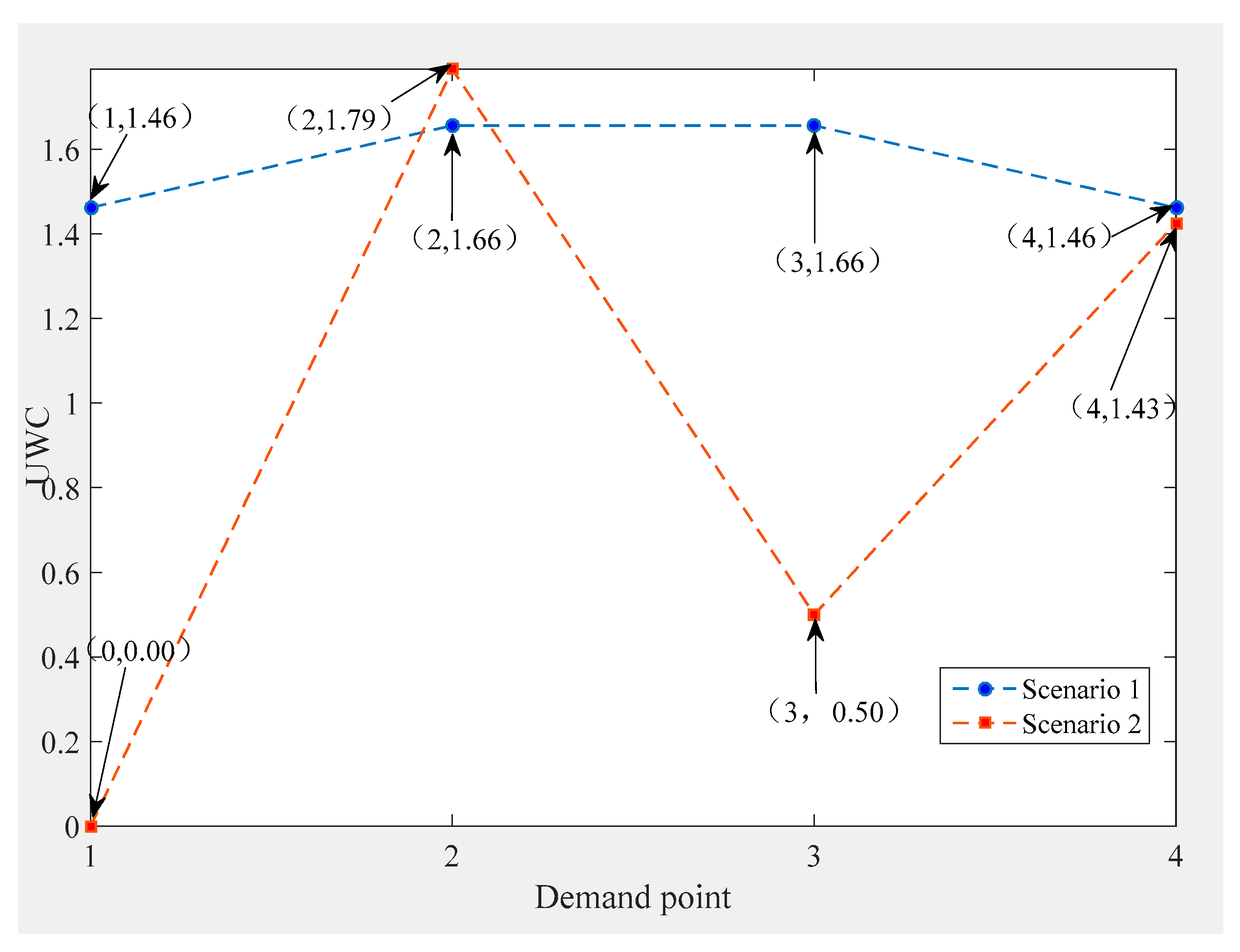

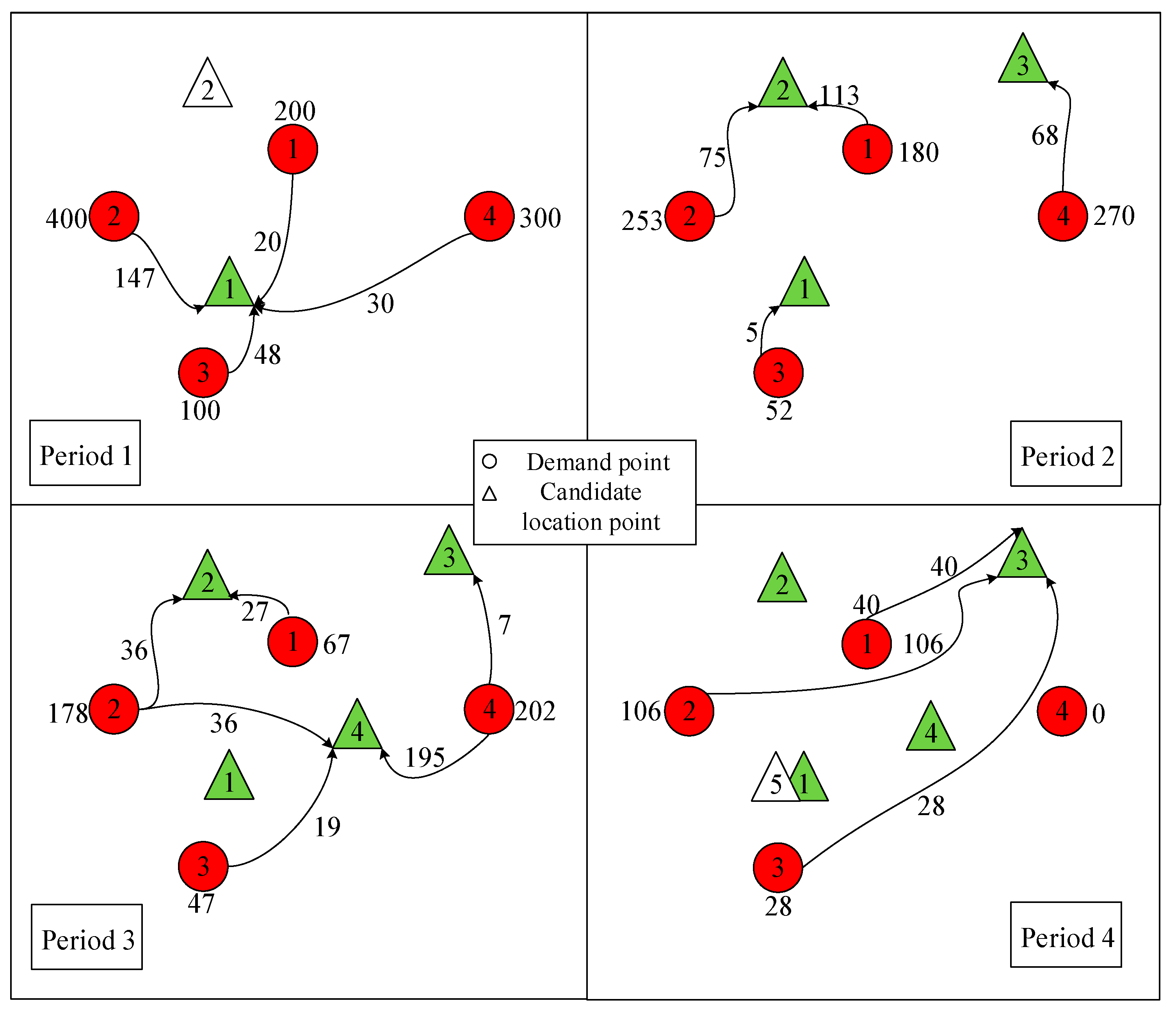

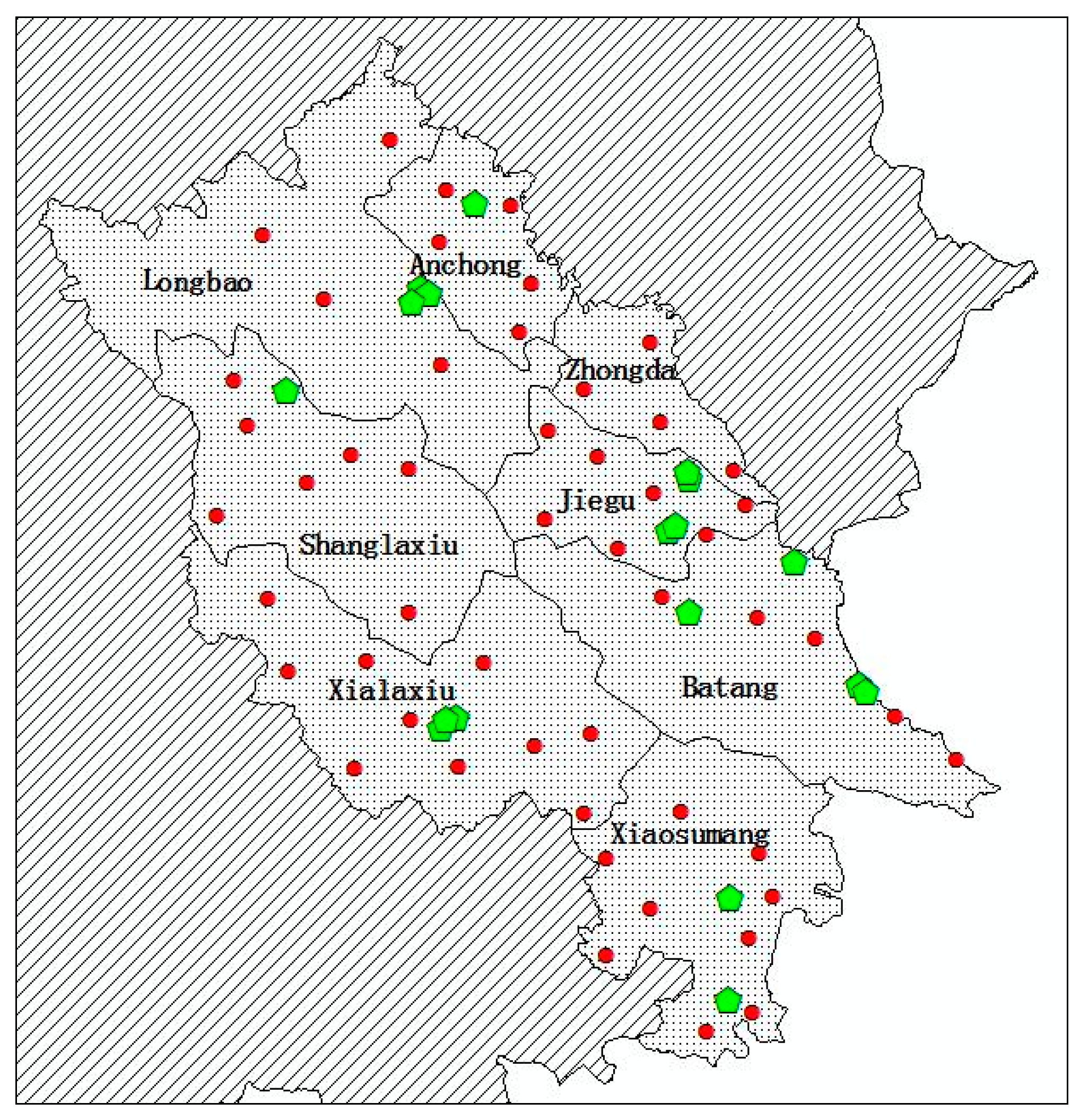
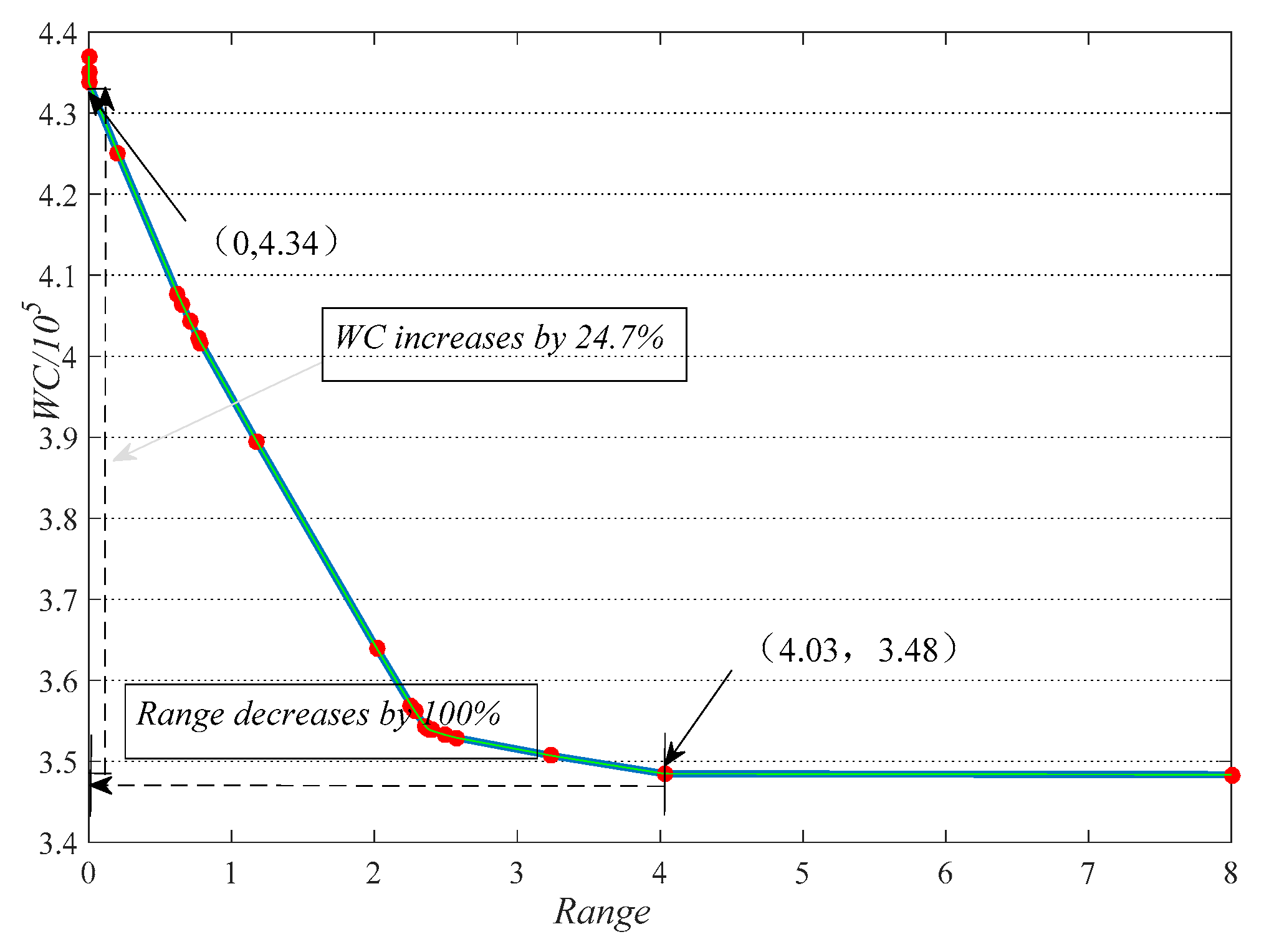

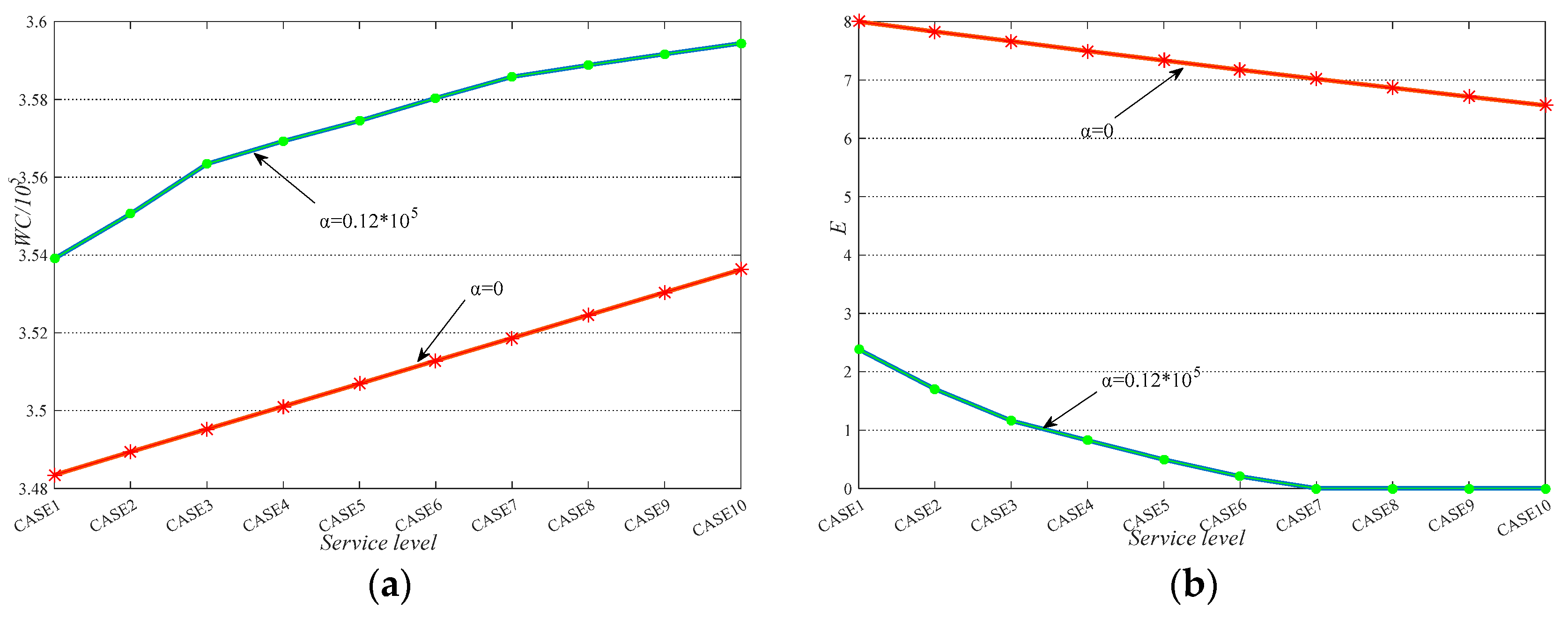
| Parameter | Value |
|---|---|
| 1, 2, 3, 4 | |
| 1, 2, 3, 4, 5 | |
| 1, 2, 3, 4, 5 | |
| , , , , | |
| , , , | |
| , , , , | |
| (km) | , , , , |
| , , , , | |
| 250 | |
| 70 | |
| 0.5 | |
| (yuan) | 400,000 |
| (yuan) | 2 |
| 1 | 2 | 3 | 4 | 5 | ||
|---|---|---|---|---|---|---|
| i | 1 | 15 | 10 | 20 | 15 | 15 |
| 2 | 8 | 20 | 40 | 25 | 8 | |
| 3 | 5 | 35 | 40 | 25 | 5 | |
| 4 | 30 | 50 | 20 | 18 | 30 | |
| No. | Purposes | Experimental steps |
|---|---|---|
| (I) | Test the sensitivities of equity weight and analyze the tradeoffs for the waiting cost and equity | (1) Use the base setting of parameters (except E). (2) Generate 101 values for equity weight from 0 to 1 × 105 by a step size of 0.01 × 105. Solve each scenario. (3) Draw and analyze the Pareto fronts between WC and equity. |
| (II) | Test the sensitivities of periodic building capacities | (1) Use the base setting of parameters. (2) For the parameter of building capacities, adjust the value by −100% … −10%, −5% … 0 … +5%, 10% … +100%. (3) For each adjustment, consider three scenarios (equity weight equals to 0, 0.12 × 105, 1 × 105). Solve DMPLA. |
| (III) | Test the sensitivities of periodic transportation capacities | (1) Use the base setting of parameters. (2) For the parameter of periodic capacities, adjust the value by −100% … −20%, −10% … 0 … +10%, +20% … +100%. (3) For each adjustment, consider three scenarios (equity weight equals to 0, 0.12 × 105, 1 × 105). Solve DMPLA. |
| (IV) | Test the sensitivities of periodic service level | (1) Use the base setting of parameters. (2) Generate 10 sets of service level constraints by a step size of 0.5%. (3) For each adjustment, solve DMPLA. |
© 2020 by the authors. Licensee MDPI, Basel, Switzerland. This article is an open access article distributed under the terms and conditions of the Creative Commons Attribution (CC BY) license (http://creativecommons.org/licenses/by/4.0/).
Share and Cite
Wang, D.; Xi, M.; Chen, Y. A Dynamic Shelter Location and Victim Resettlement Model Considering Equitable Waiting Costs. Int. J. Environ. Res. Public Health 2020, 17, 471. https://doi.org/10.3390/ijerph17020471
Wang D, Xi M, Chen Y. A Dynamic Shelter Location and Victim Resettlement Model Considering Equitable Waiting Costs. International Journal of Environmental Research and Public Health. 2020; 17(2):471. https://doi.org/10.3390/ijerph17020471
Chicago/Turabian StyleWang, Donghai, Menghao Xi, and Yingzhen Chen. 2020. "A Dynamic Shelter Location and Victim Resettlement Model Considering Equitable Waiting Costs" International Journal of Environmental Research and Public Health 17, no. 2: 471. https://doi.org/10.3390/ijerph17020471





